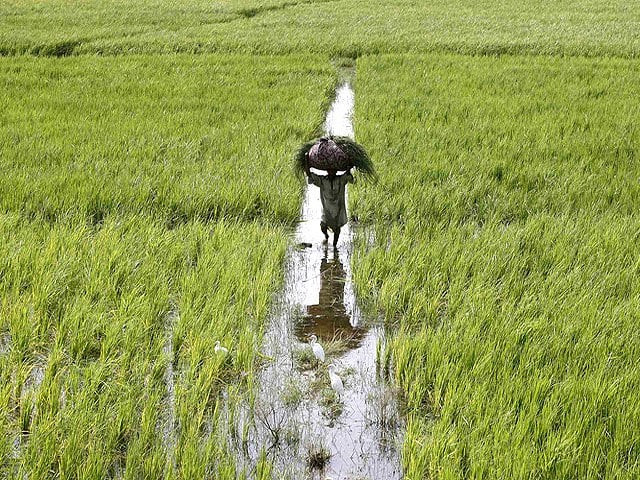Weeds cause losses amounting to Rs65b annually
Chemically controlling weeds is effective and constitutes 55% of the total pesticides used in the developed world

PHOTO: REUTERS
This was said by the University of Agriculture Faisalabad (UAF) Center of Agricultural Biochemistry and Biotechnology (CABB) Director Dr Muhammad Sarwar Khan.
Organic compost: modern way to retain soil fertility
He was chairing a departmental meeting on engineered weed management and perceptions on Wednesday at the UAF campus when he passed these remarks. He said that engineered herbicide tolerance in plants provided a superior mechanism of weed control in crop husbandry using broad spectrum herbicides.
Nevertheless, resistance development in plants particularly in weeds, and the carcinogenic effected glyphosate on human beings were being reported as implications of herbicide applications, he added.
He said that chemically controlling weeds were most effective in the developed world and constituted 55 per cent of the total pesticides used in these countries. In Pakistan, the herbicides were specifically imported from USA, Europe, Japan, or China and their usage was increasing rapidly, he added.
Khan said that these herbicides were selective in nature and killed weeds with limited damage to crops. This also released thousands of people from the drudgery of hand weeding. Being selective in nature, the use of these herbicides was species-dependent where dose of the chemical was determined, he added.
Specificity of the herbicides necessitated the development of non-selective broad spectrum herbicides that did not discriminate plants based on their age, growth rate, morphology, physiology and biochemistry, he said. However, use of non-selective herbicides demanded a novel technology that allowed desired plants to survive while leaving others susceptible, he added.
He said glyphosate was the world leading herbicide as it was affordable. GM crops were developed with a trait to tolerate the herbicide dosage, he added. About 80 per cent of the GM crops were resistant to glyphosate.
However, due to the over-reliance on glyphosate and glyphosate herbicide resistant crops, weeds were rapidly getting resistant to this class of chemicals, contrary to the pre-roundup ready arena when nearly 400 herbicides with 17 different modes of action were used, he added. Further, global consensus was building due to its health related issues, he said.

Khan said that in this regard, glufosinate had been introduced in the market as an alternative to glyphosate. Glufosinate killed weed as a contact herbicide and was applied to smaller plants. Development of glufosinate-resistant traits had been reported worldwide in corn, soybean and cotton up till now, he added.
Innovative farming: Punjab encouraging drip irrigation to overcome water scarcity
Although glyphosate beat glufosinate in cost and application timing, it was found to be more advantageous as it could kill all weeds and plants that developed resistance against glyphosate, he said. To add more in this account, no weed had been formally reported as glufosinate-resistant yet. The trait had been developed in sugarcane in Pakistan, and was being tested for field dose applications, he added.
He said that the journey that was started from mechanical methods to chemical control; and then to genetically modified crops with post-emergence application of non-selective herbicides had paid off in the form of controlled losses. However, even today there were losses due to weeds, part of them being due to the evolution of herbicide-resistant weeds, he added.
Khan said that apart from resistance development in weeds against glyphosate, there was an evolving story that glyphosate causes health risks in human beings. So, the scenario could become worse if new herbicides were not developed readily, he added.
He said that looking into details both agencies used different approaches to risk assessment. IARC assessed the cancer hazard, considering the likelihood that a chemical might, at least in some circumstances, cause the disease in humans, he added. Whereas, EFSA was principally concerned with whether there was sufficient evidence that a pesticide would not pose an unacceptable risk to human health or the environment when used following the conditions of its approval, he said.
Khan said that EFSA assessed studies conducted by the industry groups that were excluded from IARC analysis. He added that the IARC team looked only at evidence that was in public domain and was available to independent scientists for review.
Facilitating farmers: Weed eradication drive launched
He said herbicide resistant crops had a great potential in the simplification of weed management. Handled judiciously, these crops may be beneficial to the environment but should be carefully evaluated prior to releasing in a cropping system, he added.
Further, extensive and continuous use of a single herbicide should be avoided to exclude the possibilities of resistance development in plants and precautionary measures should be taken to safeguard human health, he concluded.
Published in The Express Tribune, July 20th, 2017.



















COMMENTS
Comments are moderated and generally will be posted if they are on-topic and not abusive.
For more information, please see our Comments FAQ